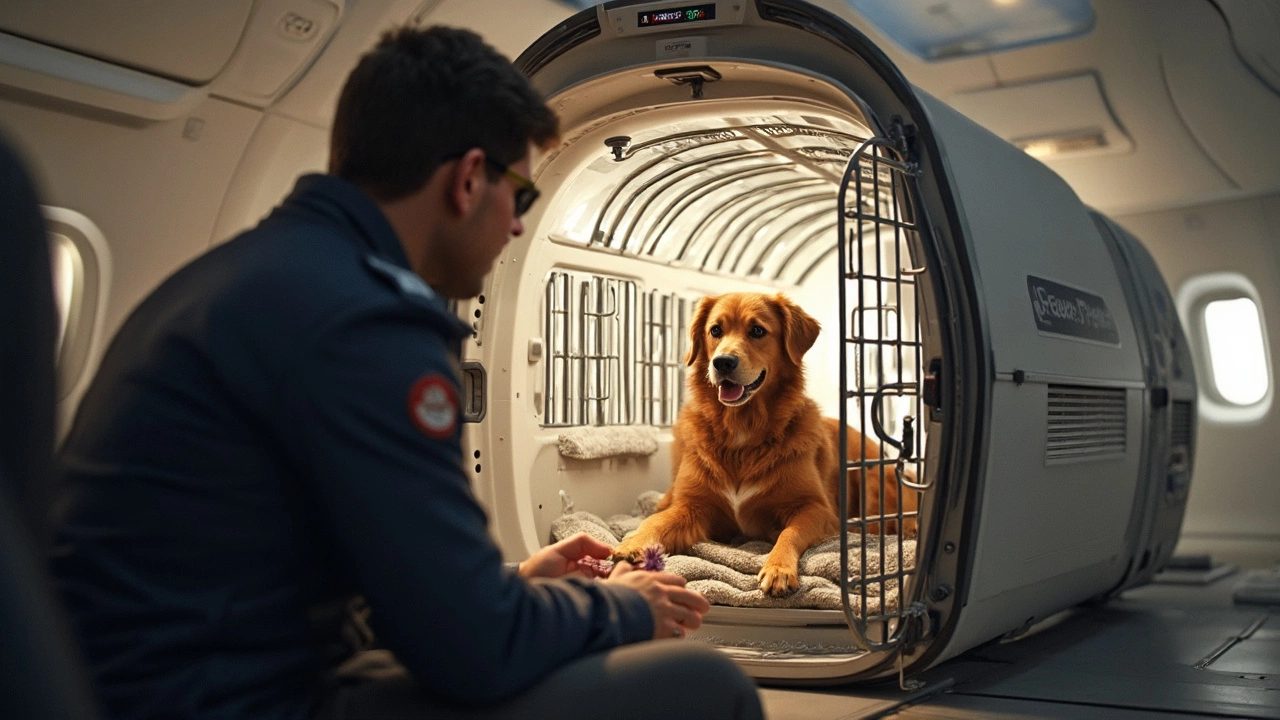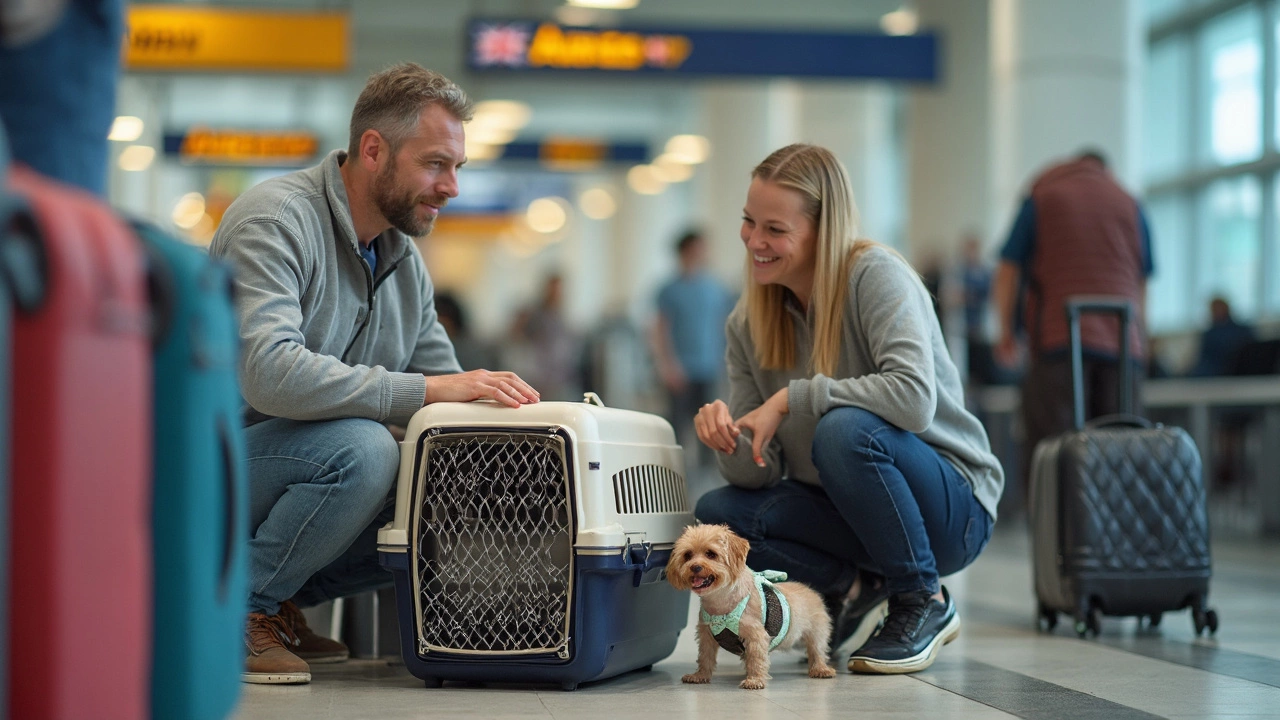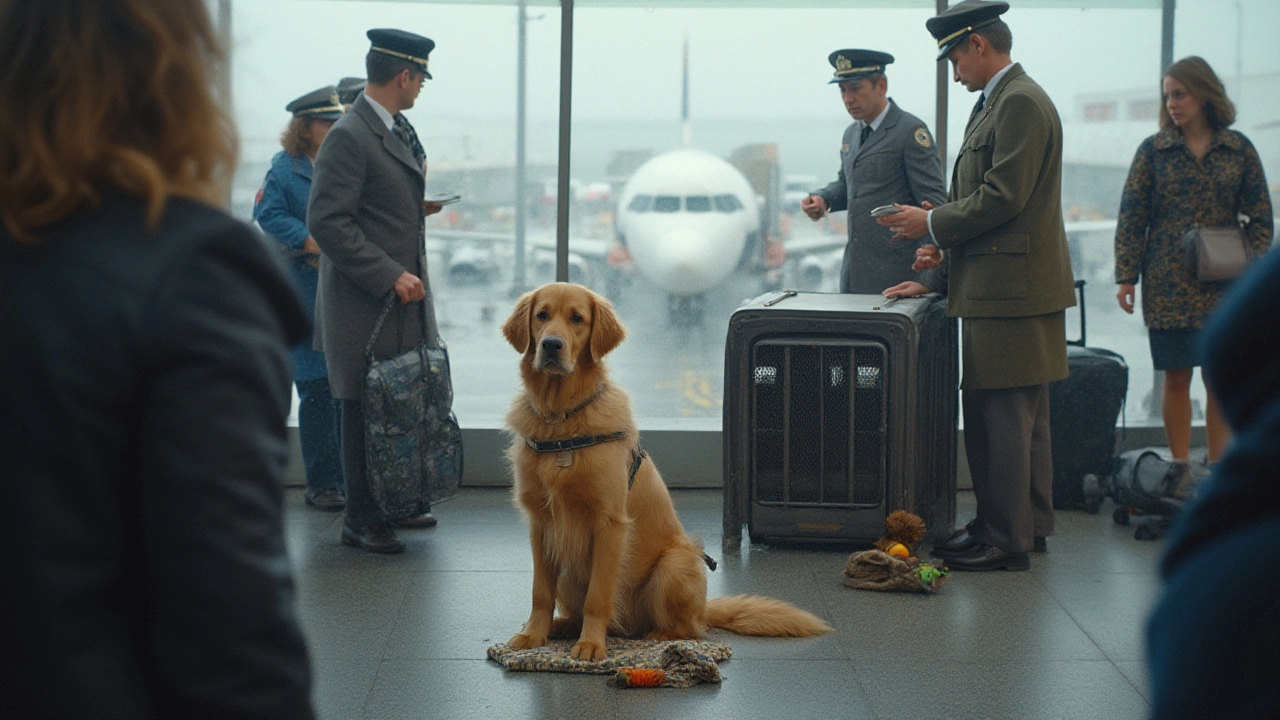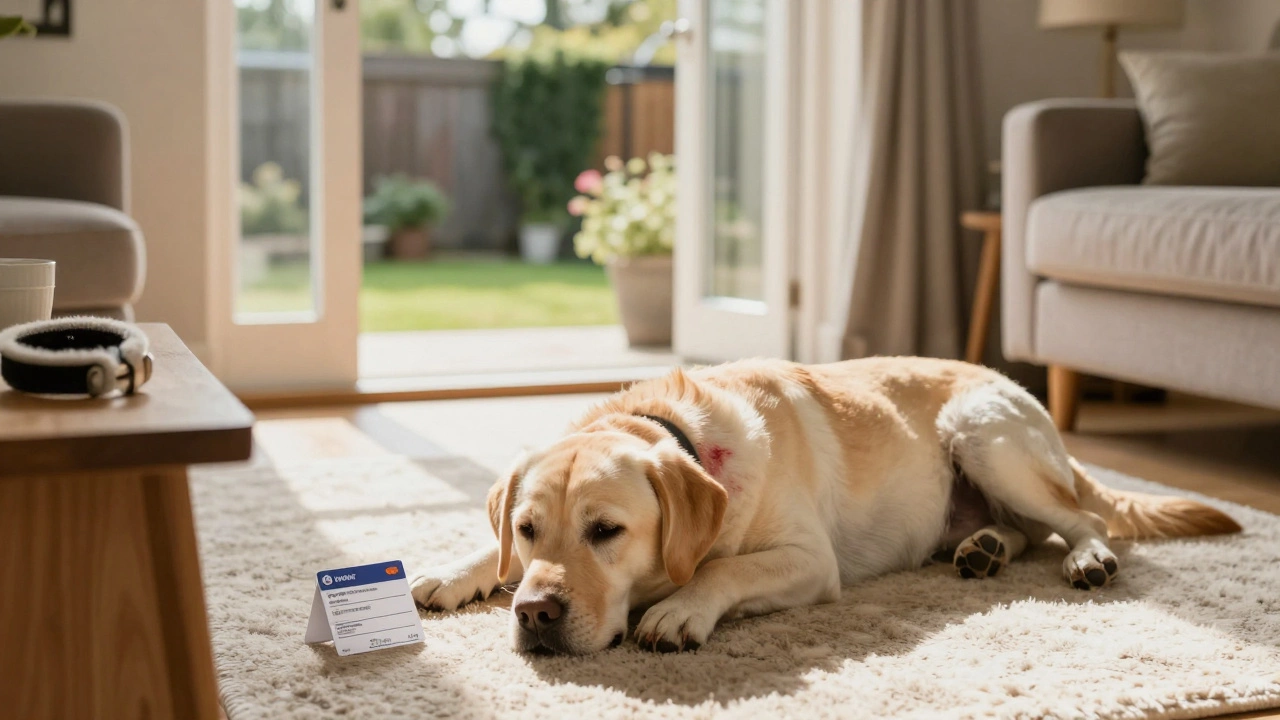Ever wondered what it's like for a dog to fly in the cargo hold of a plane? Picture this: your furry pal is suddenly in a strange place, with the rumbling of engines and the unfamiliar smell of jet fuel. It's definitely a situation that could raise any dog lover's eyebrows. Let's dive into what this experience is really like for our four-legged friends.
Flying in cargo isn't just a casual trip for dogs; it's kind of a big deal. The cargo hold isn't exactly a cozy spot. While it's pressurized and temperature-controlled, it lacks the comforting familiarity of their usual surroundings. Being in an enclosed, noisy environment can be pretty stressful.
There's more to this than just an uncomfortable plane ride. Factors like the dog's temperament, past experiences, and even the breed can affect how they'll handle the journey. Some breeds are more sensitive to stress, and for them, a trip in the cargo hold can be especially tough.
- Understanding Dog Cargo Travel
- Common Concerns and Risks
- Preparing Your Dog for Cargo Travel
- Choosing the Right Airline
- Alternatives to Cargo Travel
- Post-Flight Care for Your Dog
Understanding Dog Cargo Travel
Flying with your pup in cargo is way different from having them chill under your seat in the cabin. The cargo area of an airplane is pressurized and temperature-controlled, but it's still not the most comfortable place for a dog. Imagine being in a noisy space with strange sounds and smells, away from the cozy comforts they know.
Dogs travel in sturdy, airline-approved crates, and these are a must for keeping them safe. The crates are secured in the cargo hold, away from passengers but with various pieces of baggage. This setup isn’t ideal, but airlines take steps to ensure the environment is as pet-friendly as possible.
According to the International Air Transport Association (IATA), around 58,000 animals flew on airlines in the cargo hold safely in 2024. This stat might put pet parents at ease, but even with the best precautions, things can sometimes go awry.
"It's not just about finding the right-sized crate," says Dr. Jane Moreau, a veterinary behaviorist. "Understanding your dog's stress levels and preparing them is key to a smoother journey."
Some airlines have started to offer pet-friendly programs for cargo travel. These programs often include more frequent check-ins on the pets during the flight and specially trained staff to handle the animals. Airlines with such features are usually a bit pricier but might be worth it if you want peace of mind.
Here's what airlines usually do to make the trip smoother:
- Assign a dedicated team to check on the animals before, during, and after the flight.
- Ensure the cargo hold is pressurized and temperature-controlled specifically for pets.
- Alert the crew to report any concerns if the animals seem stressed or unwell.
For pet owners, knowing these details can help you make an informed choice when deciding whether to fly your dog in cargo. It's not just about the destination—it's about how your furry friend gets there, too.
Common Concerns and Risks
Okay, let's talk about the worries that come with packing your pooch into the cargo hold. First off, flying in cargo can be a pretty daunting experience for dogs. The main concerns usually revolve around stress, health risks, and safety during the flight.
Stress is a biggie here. The unfamiliar environment, strange noises, and the isolation can all trigger anxiety in dogs, even in those that are generally pretty chill. If your pup isn't used to being crated or left alone, this can seriously amplify the trauma.
Health-wise, certain dog breeds might face more hurdles. Take brachycephalic breeds like Bulldogs and Pugs—they have shorter respiratory tracts that can struggle with the changes in pressure and airflow, posing legit risks to their health. Plus, dehydration can be an issue since dogs don't have access to water during the flight.
Safety concerns are also a biggie. Mishandling of crates, crates getting jostled around, or even getting lost among the luggage are real worries. According to data from the U.S. Department of Transportation, there have been instances where pets have been injured or lost during flights. In 2023, airlines reported 50 incidents involving animals; most were related to injuries during transit.
So, how can you tackle these concerns? Consider your dog's size, breed, and temperament before deciding on flying with pets in cargo. Always double-check the airline's regulations and see if they have specific policies for animal safety. Some airlines even offer specific training for handlers, which can be a step towards reducing these risks.
- Consult your vet to make sure Fido is fit for flight.
- Use a sturdy, well-ventilated crate that's airline approved.
- Make sure your dog's ID tag and microchip are up to date.
Keep these tips in mind to ease some of the stress and risks involved in flying dogs in cargo. Your mindset going into this matters, and prepping right can make all the difference for your furry traveler.
Preparing Your Dog for Cargo Travel
Getting your dog ready for flying in cargo isn't just about tossing them in a crate and hoping for the best. It's about making the whole experience as smooth and stress-free as possible. Here's how you can do that.
First off, it's important to get your buddy used to spending time in a crate before the flight. Start by getting a dog travel crate that meets airline requirements. It should be well-ventilated and large enough for your pup to stand, turn, and lie down comfortably. Let them explore it at home and throw in some of their favorite toys or a blanket to make it feel like a safe space.
Next, consider getting them accustomed to your car, if they're not already. Dogs who are used to car travel are usually more adaptable to the motion and noises they'll experience in flying with pets. Take them on short drives to see how they react and reward them with treats or praise for calm behavior.
- Visit the vet: Before any flight, check in with your vet to ensure your dog is fit to fly. Airlines might require a health certificate, proving your pet is up-to-date on vaccinations and free of illness.
- Plan meals wisely: Try not to feed your dog a heavy meal just before the flight. A light meal a few hours before takeoff is usually best, reducing the chance of travel-induced nausea.
- Identify and label: Clearly mark your crate with "LIVE ANIMAL" stickers, and add contact info, including your mobile number, just in case.
- Pre-flight exercise: Let your dog burn off some energy before heading to the airport. A tired dog is more likely to settle down and rest.
- Stay calm: Dogs are sensitive to our emotions. If you're stressed, they might be too. Keep your vibe chill to help your furry friend feel the same.
You might wonder about calming products. Some folks use anxiety vests or consult with their vet about sedatives, but remember, it's not about knocking your dog out; it's helping them stay calm.
This prep process can take time, so start getting your pup ready well before the flight. Your efforts can make a huge difference in how your pet handles pet cargo travel.

Choosing the Right Airline
Picking the right airline for your dog's trip can make a huge difference in their flying experience. Some airlines are more dog-friendly than others, offering extra measures to ensure a safe and less stressful journey. Here's what to look for when booking a flight for your furry buddy.
First, it's important to check the airline’s pet policy thoroughly. Not all airlines allow pets in cargo travel, and those that do might have specific requirements. You’ll want to confirm the crate specifications, temperature regulations, and any breed restrictions they might have.
Another key factor is the airline's reputation for pet travel. Some, like Delta and American Airlines, have invested in pet travel programs, focusing on improving conditions in the cargo hold. They also provide dedicated staff to monitor pets during the flight. It's worth checking out reviews from other pet owners who've flown with these airlines to get an idea of what to expect.
Different airlines might also have varying requirements for health checks. Some request a veterinarian's approval prior to the flight, while others have specific vaccination rules. Make sure to gather all necessary paperwork ahead of time to avoid last-minute surprises.
It might be helpful to compare several airlines' policies on flying with pets in one glance. Here's a snapshot:
| Airline | Pet Program Highlight | Breed Restrictions |
|---|---|---|
| Delta | Pets First Program ensuring safety monitors | Short-nosed breeds restricted |
| American Airlines | Climate-controlled cargo holds | Certain large breeds restricted |
| JetBlue | No pets in cargo | All breeds restricted in cargo |
While price might be a factor when choosing an airline, don’t let it be the only one. The comfort and safety of your pet should be the top priority. Taking the time to research and choose an appropriate airline ensures dog travel will be as smooth as possible for your cherished companion.
Alternatives to Cargo Travel
Okay, so flying in the cargo hold might not be the best option for every dog. Good news—there are other ways to get your pup from point A to point B safely.
First up, ever thought about bringing your dog into the cabin with you? Some airlines let small dogs ride with their humans, tucked away in an approved carrier under the seat. Of course, size limits apply, and you'll probably need to make arrangements in advance since spots are limited.
Next, how about a pet relocation service? It might sound fancy, but these services take care of all the logistics—booking, paperwork, and finding the best travel route for your furry friend. While they can be a bit pricey, the peace of mind they offer is worth considering if you're not keen on the whole cargo deal.
Let's not forget classic road trips. If your schedule allows, hitting the road together could be way more fun and definitely less stressful for your dog. Plus, you control the pace, allowing for necessary breaks and the chance to stretch their paws. Don't forget to pack essentials like water, food, toys, and a comfy blanket.
Lastly, there's always the option of leaving your dog at home with a trusted minder or in a reputable pet hotel. If your travel plans are short-term, this might be the least stressful choice for everyone involved. Just make sure they're in good hands.
So, if the idea of cargo travel has you second-guessing, don't worry, there's probably an alternative that fits your lifestyle and makes both you and your dog happy travelers.
Post-Flight Care for Your Dog
Once your dog has landed after their cargo adventure, you’ll want to make sure they're feeling their best. The period right after the flight is critical for checking their well-being. Keeping a close eye on them is key to ensuring they're okay.
First things first, give your dog some time to adjust their surroundings. They might be a bit disoriented or anxious. Settle them down with some gentle words and lots of affection. You’d be surprised how comforting familiar sounds and smells can be to your furry friend.
Before you leave the airport, ensure that your dog is in good shape. Check for any signs of distress or health issues. Look for things like difficulty breathing, excessive drooling, or if they seem unusually lethargic. If you notice anything odd, it’s important to consult a vet right away.
Offering water and a small snack can also help a lot. Flying can be dehydrating and a bit of food can bring back their energy. But just a little something – you don't want to upset their stomach after the flight.
Once you’re home, it's time for some quality relaxation. Let your pup unwind and get back into their routine. A short walk can help them settle back in and stretch out after the journey. Don’t forget: this is a big change for them, and they might just need a little patience and some of that good old love.
In case you’re planning regular air travel with your dog, tracking their behavior post-flight over time is smart. Note any issues and consider consulting a vet specialized in travel-related pet stress if needed. With practice and understanding, traveling can become less daunting both for you and your dog.






